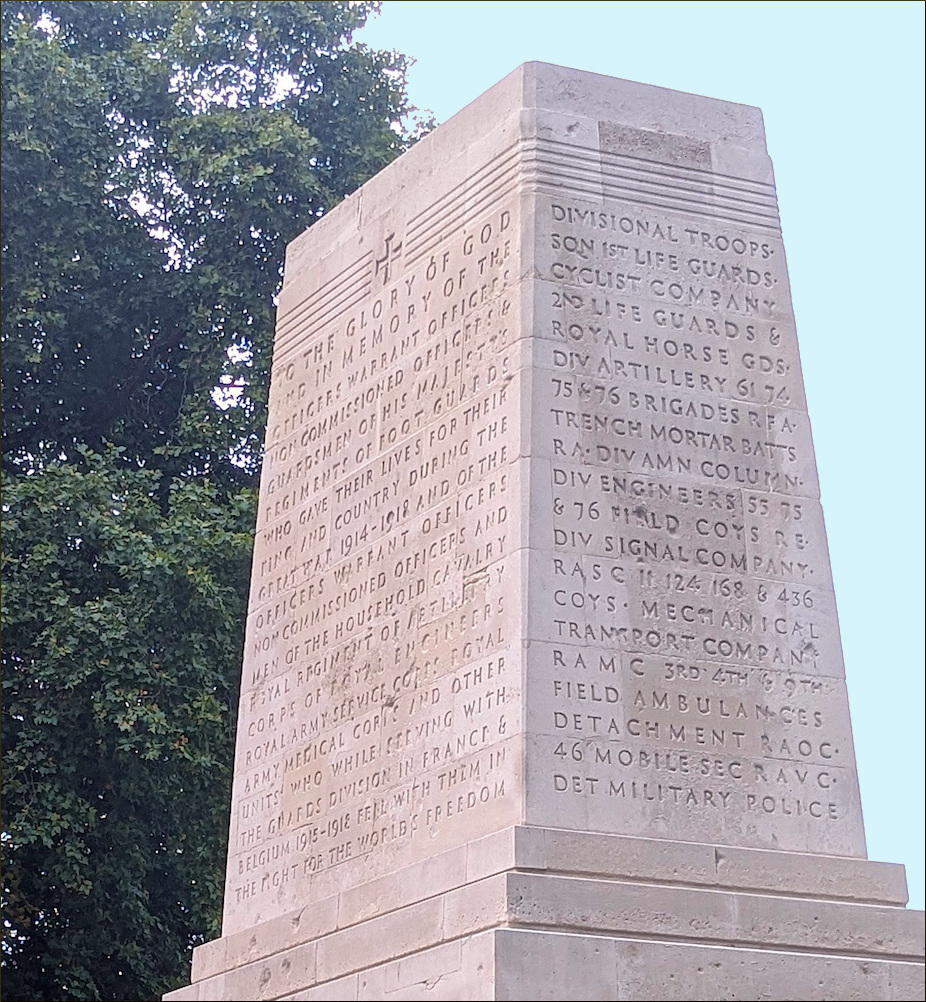

The Guards Division War Memorial, London. Unveiled in 1926, this is a collaborative work. The lettering was by Ernest George Gillick ARA (1874-1951). The over-lifesize figures of Guardsmen (Scots, Welsh and Irish, together with Grenadier and Coldstream), and the relief panels of war equipement and the loading of a field gun, were the work of Gilbert Ledward (1888-1960). The architectural design was by Harold Chalton Bradshaw (1893-1943). Of Portland stone with bronze sculptural additions, the memorial is 38'6" high, and prominently sited beside Horse Guards Road to overlook Horseguards Parade, Whitehall. It is Grade I listed by Historic England. [Click on the images to enlarge them.]
The main inscription on the front of the upper part of the memorial was composed by Rudyard Kipling, whose son John had joined the Irish Guards and died in the Battle of Loos at the age of eighteen (see Bove and Rowe 125). A contemporary account in the Staffordshire Sentinel praised the inscription's "Roman reticence" (qtd. in "Central London: Guards Memorial, Horse Guards Parade"). It reads:
To the Glory of God/ And in the memory of the/ Officers, Warrant Officers/ Non-commissioned officers &/ Guardsmen of His Majesty's/ Regiments of Foot Guards/ who gave their lives for their/ King and Country during the/ Great War 1914-1918 and of the/ Officers, Non-Commissioned Officers Warrant Officers/Non commissioned officers and/ Men of the Household Cavalry/ Royal Regiment of Artillery/ Corps of Royal Engineers/ Royal Army service Corps Royal/ Army Medical Corps and other/ Units who while serving with/ The Guard's Division in France &/ Belgium 1915-1918 fell with them in/ The fight for the World's Freedom.
On the sides are listed the various units which took part (including, interestingly, a cyclist company), and their battle honours. Below is added, in the same spare and elegant lettering, an inscription to the Guardsmen who fell in World War II.
War memorial inscriptions may not seem such a vital part of the overall artistic effect, but they are. Clarity, fundamental though that is, is not enough. Proportion, spacing and pleasing letter forms need to be considered too. Above and beyond all that is an effect less easy to define:
The major importance of lettering as an element of effect in memorial design cannot be over emphasized. In both significance and beauty it cannot be rivaled by either surface or contour decoration. Properly designed by a skilled letterist, and expressing a sentiment born of the soul, the inscription on a memorial is and should be the dominant feature of the monument.... these inscriptions carry a message to posterity; and that is the fundamental function of any memorial. ["Annual Review of Monuments of the Year...," 34]
Gillick was clearly a "skilled letterist" — an art often overlooked. His role here, like Kipling's, is seldom mentioned.
Links to Related Material
- Old colour postcard of Horse Guards, Whitehall, the picturesque eighteenth-century guardhouse and HQ leading through to the parade ground from Whitehall
- Edwardian-era photograph of Horse Guards
- The Old Artillery Building fronting the parade ground
- The Guards Crimean War Memorial at the junction of Lower Regent Street and Pall Mall
Text by Jacqueline Banerjee and photographs taken and kindly provided by Robin Banerjee. [You may use these images without prior permission for any scholarly or educational purpose as long as you (1) credit the photographer and (2) link your document to this URL in a web document or cite the Victorian Web in a print one.]
Bibliography
"Annual Review of Monuments of the Year...." Monumental News Review, 1948: 33-42. Internet Archive. Web. 10 September 2025.
Bove, Cheryl, and Anne Rowe. Sacred Space, Beloved City: Iris Murdoch's London. Newcastle: Cambridge Scholars, 2008.
"Central London: Guards Memorial, Horse Guards Parade." Roll of Honour. https://www.roll-of-honour.com/London/GuardsMemorialHorseGuardParade.html. Web. 10 September 2025.
Ernest George Gillick ARA.” Mapping the Practice and Profession of Sculpture in Britain and Ireland 1851-1951. University of Glasgow History of Art and HATII. Web. 9 September 2025.
"The Guards Memorial." Historic England. Web. 9 September 2025.
Created 11 September 2025